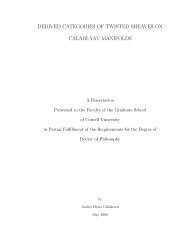FIVE MAJOR RESULTS IN ANALYSIS AND TOPOLOGY Aaron ...
FIVE MAJOR RESULTS IN ANALYSIS AND TOPOLOGY Aaron ...
FIVE MAJOR RESULTS IN ANALYSIS AND TOPOLOGY Aaron ...
Create successful ePaper yourself
Turn your PDF publications into a flip-book with our unique Google optimized e-Paper software.
3. THE STONE-WEIERSTRASS THEOREM 21<br />
f = λg and f = u + iv, then u(x) > 0, so that AR vanishes at no point of K. By the real<br />
version of the Stone-Weierstrass theorem, the uniform closure of AR in A is C(K, R), and is<br />
contained therefore in B, the uniform closure of A. The result follows from noting that B is<br />
a complex algebra, and that if f ∈ C(K, C) then f = u + iv is in B because u,v are in the<br />
uniform closure of AR ⊂ B. <br />
There is an even further generalization of the Stone-Weierstrass theorem, which was<br />
proved by Erret Bishop in 1961. The result, Bishop’s Theorem, can be found in [1] and [11].<br />
As discussed before, the Stone-Weierstrass theorem and its special cases appear through-<br />
out analysis, but primarily in results that involve maps into scalar fields. We will conclude<br />
by providing a few interesting results which rely on this theorem.<br />
The following extension of the Weierstrass approximation theorem which, although it is a<br />
trivial corollary of the Stone-Weierstrass theorem, can be used to extend many of the results<br />
of one-dimensional analysis into two dimensions.<br />
Theorem (Extension of Weierstrass Approximation Theorem 1 ). If K ⊂ R 2 is compact,<br />
and if f ∈ C(K, C), then there is a polynomial g(x1,x2) such that |f(x1,x2) − g(x1,x2)| < ǫ<br />
for every (x1,x2) ∈ K.<br />
The following result, from functional analysis, in incredibly useful. The n th moment of a<br />
real continuous function f defined on [0, 1] is the value of the integral<br />
1<br />
0<br />
f(x)x n dx.<br />
Theorem (Moments of Real Functions 2 ). Let f,g be real continuous functions defined<br />
on [0, 1]. Then f and g are identical if, and only if, the n th moments of f and g agree for<br />
every n ∈ N.<br />
This last result implies the following theorem.<br />
Theorem (Number of Continuous Real Functions). The cardinality of the set of contin-<br />
uous real functions defined on [0, 1] is equivalent to that of R.<br />
1 Taken from [13].<br />
2 Taken from [13].
















